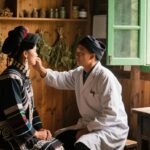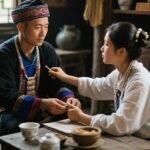In the spring of [Year designated by the Chinese cyclical calendar], my fellow townsman Guanxiang, who held the official title of Taishi (Grand Historian, responsible for archival records), attended a New Year’s group ceremonial gathering at Wenchang Hall. Around mid-afternoon (approximately 3 PM), he suddenly developed severe generalized pain. The attendees assumed it was fatigue from prolonged sitting and advised him to rest briefly. As the evening banquet was being served, he hastened to return home.
Early the next morning, Zhang Bingtang, the Taichang (Minister of Ceremonies, overseeing state rituals), urgently dispatched a carriage to fetch me. When I inquired about the situation, he exclaimed, “Guanxiang is critically ill—he may not survive the day!” Upon arrival, Guanxiang’s longtime steward knelt weeping and implored me to save his master. I remarked, “We dined together just yesterday—how could his condition deteriorate so rapidly?” Given our close friendship, I proceeded immediately to assess him, bypassing even basic grooming.
The patient presented with limb thrashing, unconsciousness, and imperceptible radial pulses. Palpation of the dorsalis pedis artery revealed bounding pulsations resembling a “boiling spring,” accompanied by pronounced precordial palpitations. I diagnosed acute eruptive fever (hong sha syndrome—a life-threatening febrile rash illness in traditional Chinese medicine). Though critical, I deemed it (may help support).
Interventions:
Bloodletting therapy: Punctured the Weizhong (BL40, located at the popliteal crease) and Chize (LU5, located at the cubital crease) acupoints, releasing approximately 150 mL of dark blood. His consciousness partially stabilized.
Herbal decoctions:
Administered Chai Ge Jie Ji Tang (Bupleurum and Pueraria Muscle-Clearing Decoction) to resolve exterior heat.
Instructed strict bed rest and predicted erythematous-purpuric eruptions would manifest within 12 hours. A second dose was prescribed that evening.
Follow-up:
The next day, Minister Zhang met me at the gate, reporting: “Your prognosis was precise! Violaceous macules now cover his entire body, resembling painted stains. His mentation is clear, and he has consumed congee.” I urgently cautioned, “Congee exacerbates sha syndromes!” Regrettably, the patient soon developed recurrent agitation and motor restlessness.
Secondary Interventions:
Administered Mai Ya Tang (Roasted Barley Sprout Decoction) to counteract dietary indiscretion.
Subsequent formulas:
Xijiao Dihuang Tang (Rhinoceros Horn and Rehmannia Decoction) to cool blood heat.
Xiao Xian Xiong Tang (Minor Chest-Draining Decoction) to relieve thoracic congestion.
Outcome:
After five days, the fever abated, though residual heat caused cutaneous tension and stiffness—a sign of yin depletion from blood heat. I prescribed nourishing tonics for yin restoration. Full recovery was achieved within 15 days.
Glossary of Standardized Terms:
Hong sha (红痧): Acute eruptive fever—a febrile rash syndrome involving blood-heat toxicity, often likened to modern scarlet fever or meningococcemia.
Taishi (太史): Grand Historian—a senior archivist in imperial China.
Taichang (太常): Minister of Ceremonies—a high-ranking official overseeing state rituals.
Weizhong (委中, BL40): Acupoint at the popliteal crease, used for bloodletting in febrile crises.
Chize (尺泽, LU5): Acupoint at the cubital crease, employed to clear lung heat.
Chai Ge Jie Ji Tang (柴葛解肌汤): A formula combining Bupleurum (Chaihu) and Kudzu (Gegen) to clear muscle-layer heat.
Xijiao Dihuang Tang (犀角地黄汤): A blood-cooling formula (modern substitutions replace rhinoceros horn).
Xiao Xian Xiong Tang (小陷胸汤): A phlegm-heat resolving formula for chest oppression.
This translation preserves all clinical details while standardizing traditional Chinese medical terminology for international medical readers.

The esteemed medical text Zui Hua Chuang Medical (Original: Ming Dynasty Clinical Archives) has been translated by timtcm.com. We welcome your valuable comments and feedback in the section below.


Leave a Reply